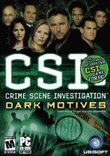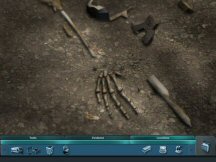A few years ago, you could mention
crime scene forensics, and people would look at you as though you
offered them hearts of palm. Sure, they knew that there were people
out there that did the dirty work of picking up evidence, but they
hadn’t a clue what methods were used, or how important those that
perform this job can be to the successful conclusion of a criminal
case.
With the runaway success of CSI: Crime Scene Investigation on
television, and the spin off CSIs supposedly taking place all over
the country, the common man can now determine many aspects of how a
crime scene needs to be approached, such as what forensics tool
would be necessary to locate evidence. I can imagine a bona fide
crime scene investigator hard at work on a scene, and having an
eighty year old lady with two French clipped poodles casually look
over his shoulder and say “You might try the luminol and the
electrostatic dust print lifter – it works well for me.” No doubt
the police officer would be grateful for the unexpected assistance.
Then there was the advent of the computer game CSI, which has
been followed by CSI: Dark Motives and CSI: Miami. Here we’re mainly
going to take a look at CSI: Dark Motives, the second in the series.
Does it have an authentic feel about it, and is it enjoyable? More
on that later.
THE STORY
“I hope you aren’t squeamish, because the body of evidence on
any murder case starts with the body as evidence”
You the player enter the game as a recent graduate of crime scene
investigation school. You are directed to a fresh crime scene by
your new boss Gil Grissom, and you’ll be working with Catherine
Willows on your first foray into the world of criminal forensics.
The first case concerns a dare devil motorcycle stunt “gone bad” –
did someone tamper with the motorcycle, or was it just an unlucky
accident?
A successful completion of this case will be followed by four
other cases, each accompanied by one of the investigators from the
TV show: the strong but soft spoken Nick Stokes, the humorous and
easy going Warrick Brown, the sassy Sara Sidle, and culminating with
the hunky Gil Grissom. Accompanied, but the investigation is up to
you to solve. You choose the appropriate tools of the trade, and
decide where the suspect focus is going to be. You decide in which
order to go to locations, and when to approach Captain Brass to
attempt to obtain a warrant, with side trips to the medical examiner
and the lab. Along the way if you find yourself stuck, you can ask
the other investigator for assistance, but this will count against
your total score. Finishing each episode with high points will allow
you to see extra material, such as art work. Theoretically anyway,
it would seem that even if you ask several times for help, you will
still score high enough to see the extras – and you can safely miss
this anyway, on the grand scale of excitement.
More exciting are the cut scenes, which appear when you find a
particular piece of evidence, just as in the TV show. Although they
usually aren’t helpful in solving your case, they are nevertheless
interesting.
The bestselling author Max Allan Collins, who wrote the novels
based on the series, is also the consultant for this game.
INSTALLATION AND GAMEPLAY
“That’s what we call around here a theory – which is what
it’ll stay, unless you can come up with some supporting evidence.”
Installation is problem free, and there’s a choice of minimal or
full install. The CD does have to be in the drive to play the game.
You have the option to play as beginner, intermediate or advanced,
which is an improvement over the first CSI game which didn’t have
that feature. Playing as a beginner will allow you to select active
hotspots, evidence tagging, automatic questions for witnesses, and a
tutorial. The tutorial isn’t separate, but consists of a disembodied
voice talking in generalities during game play when you are trying
to absorb the story line.
The active hotspots are a wonderful feature. If you elect to play
advanced without these active hotspots, you can spend a week one
afternoon looking for evidence in the pixel hunt to end all pixel
hunts. The automatically generated questions are nice as well,
unless you prefer to drag the evidence icons one by one to the
person you’re trying to talk to, in the hope that you can elicit
some dialogue.
Movement is point and click, and although you can sweep around in
a circle, your forward motion is limited to areas where there is
something of importance to the story. You click on items to get a
closer view of them, and then select a tool to search for evidence,
or a tool to pick it up correctly. For example, you might search
using a magnifying scope, discover a stain, apply luminol to
determine that the substance is blood, and then use a swab to
collect it for processing at the lab. In addition, a piece of
evidence may in closer view reveal an additional item of evidence,
such as a fingerprint or a strand of hair that was not obvious on
first glance. When you discover this “hidden” evidence, the game
does a fast close up with sound effects at warp speed, which I
thought was very entertaining indeed. Even after you discover this
hidden evidence and remove it for processing, the game will continue
to do the fast focus where it was, and you can continue to be amused
as long as you wish.
Essential to the stories are your visits to the laboratory and to
the morgue when you have a deceased victim. In the laboratory you
hand over your evidence, and most of the work is done for you by the
technician. However, you are responsible for some activity, such as
running the fingerprints through the computer program for a possible
identification, or looking through the microscope to compare two
hairs for similarity. Without fail, when I became stuck for a time
in the game and couldn’t fathom what I hadn’t completed, it was
because I hadn’t turned in a piece of evidence, or had not looked in
the microscope or at the computer program to fulfill that element
for a successful conclusion to the case.
Once you have established sufficient evidence, you can obtain a
warrant through the Captain for a suspect, or a search warrant for a
location. This may lead to a successful conclusion to the episode,
or may show a new twist to the case, and it is back to the drawing
board. You also get to visit the Captain when you need an address.
This struck me as fairly humorous – he must have some doubts about
his investigators, since he won’t allow them to look up addresses by
themselves. What a job!
The tools and evidence you have collected are all available
through a very user friendly interface. Tools are divided between
those that can locate evidence, and those that can collect evidence.
Evidence itself is divided to make it more manageable. In addition,
you have access to the cut scenes, and you have a tab sorted log
that indicates how much evidence you have against a subject, or what
progress you have made in identifying a body.
After a case is concluded, you are given a few multiple choice
bonus questions to answer. Correct answers will of course add to
your point total.
Your progress is saved automatically, and upon loading the game
you will return to where you left off of the game when you played
before.
GRAPHICS
“Let’s go see where fantasy mixed up reality”
CSI: Dark Motives has better graphics than the first CSI game,
but not as smooth as CSI: Miami, a natural progression I’m glad to
see. The characters are recognizable as the people acting in the TV
show, which will no doubt delight the CSI aficionados. But the
graphics still remain only adequate in their grainy simplicity.
SOUND
“Hey, this isn’t amateur night”
The voiceovers of the characters were accomplished by the actual
TV CSI cast. Again, this is a feature that will probably be a warm
and fuzzy for fans of the series. Unfortunately, not all the cast
carries the same enthusiasm for this project, and on occasion I
suspect they had to be prodded awake to say their lines.
Sound effects are unremarkable, and the music is – no surprise,
the music from the CSI TV show. It isn’t annoying, or particularly
memorable.
MATURE CONTENT
“Let’s keep our eyes-and minds-open”
Not surprising with a crime scene theme, there is content that
may frighten children or disturb some adults. Dead bodies and gore
abound, although nothing is gratuitous.
OVERALL
Fans of the CSI series will no doubt be enthusiastic about the
game, and grade it much higher than I did. If you aren’t a fan of
the series, as I am not, it still provides a pleasant few hours as
one of those “tweener” games – when you don’t wish to embark on a
long adventure. Having the separate episodes makes it perfect for
those days when you have little time to devote to a game.
I was pleasantly surprised and absorbed in my game playing, and
there are enough twists and turns so that it’s not an automatic cake
walk. The various tools were easy to use, and I appreciated the fact
that they were tools actually used by crime scene professionals, and
not something made up for the game. I did however cringe a bit when
evidence was picked up without first being photographed, and I
wonder why this wasn’t a tool option for the sake of authenticity.
Perhaps this was merely a step taken to “keep it simple.”
In the real world, crime scene investigators don’t interrogate,
interview, or investigate outside of the crime scene and lab. Of
course, this would make for a rather dull gaming experience, so
poetic license is warranted here.
Grade: C+
design copyright ©
2005
GameBoomers
Group

